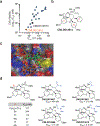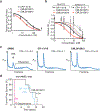Amidino-Rocaglates: A Potent Class of eIF4A Inhibitors
- PMID: 31519508
- PMCID: PMC6874763
- DOI: 10.1016/j.chembiol.2019.08.008
Amidino-Rocaglates: A Potent Class of eIF4A Inhibitors
Abstract
Rocaglates share a common cyclopenta[b]benzofuran core that inhibits eukaryotic translation initiation by modifying the behavior of the RNA helicase, eIF4A. Working as interfacial inhibitors, rocaglates stabilize the association between eIF4A and RNA, which can lead to the formation of steric barriers that block initiating ribosomes. There is significant interest in the development and expansion of rocaglate derivatives, as several members of this family have been shown to possess potent anti-neoplastic activity in vitro and in vivo. To further our understanding of rocaglate diversity and drug design, herein we explore the RNA clamping activity of >200 unique rocaglate derivatives. Through this, we report on the identification and characterization of a potent class of synthetic rocaglates called amidino-rocaglates. These compounds are among the most potent rocaglates documented to date and, taken together, this work offers important information that will guide the future design of rocaglates with improved biological properties.
Keywords: amidino-rocaglates; eIF4A; eIF4F; interfacial inhibitor; translation initiation.
Copyright © 2019 Elsevier Ltd. All rights reserved.
Conflict of interest statement
Declaration of Interests
J.C., W.Z., J.A.P. Jr, and J.P. have filed a US provisional patent application on the use of amidino-and amino-rocaglates as potent translation inhibitors and anticancer agents.
Figures




References
-
- Abramson RD, Dever TE, Lawson TG, Ray BK, Thach RE, and Merrick WC (1987). The ATP-dependent interaction of eukaryotic initiation factors with mRNA. J Biol Chem 262, 3826–3832. - PubMed
-
- Bhat M, Robichaud N, Hulea L, Sonenberg N, Pelletier J, and Topisirovic I (2015). Targeting the translation machinery in cancer. Nat Rev Drug Discov 14, 261–278. - PubMed
-
- Bordeleau ME, Matthews J, Wojnar JM, Lindqvist L, Novac O, Jankowsky E, Sonenberg N, Northcote P, Teesdale-Spittle P, and Pelletier J (2005). Stimulation of mammalian translation initiation factor eIF4A activity by a small molecule inhibitor of eukaryotic translation. Proc Natl Acad Sci U S A 102, 10460–10465. - PMC - PubMed
-
- Boussemart L, Malka-Mahieu H, Girault I, Allard D, Hemmingsson O, Tomasic G, Thomas M, Basmadjian C, Ribeiro N, Thuaud F, et al. (2014). eIF4F is a nexus of resistance to anti-BRAF and anti-MEK cancer therapies. Nature 513, 105–109. - PubMed
Publication types
MeSH terms
Substances
Grants and funding
LinkOut - more resources
Full Text Sources
Other Literature Sources
Miscellaneous

